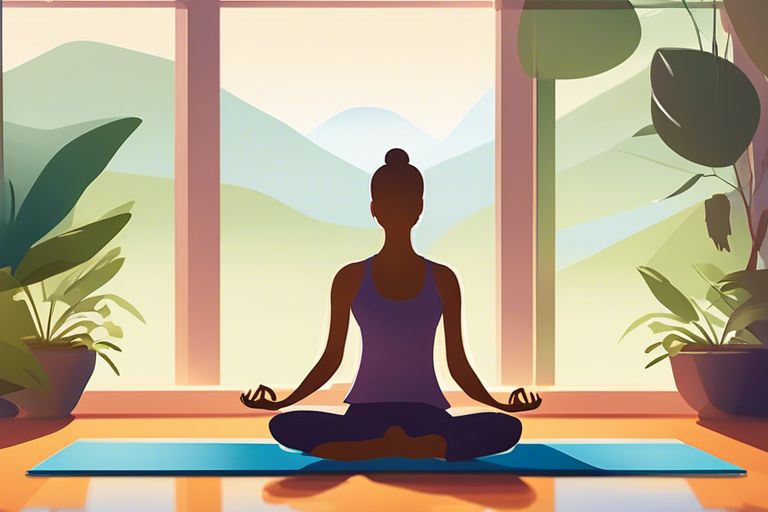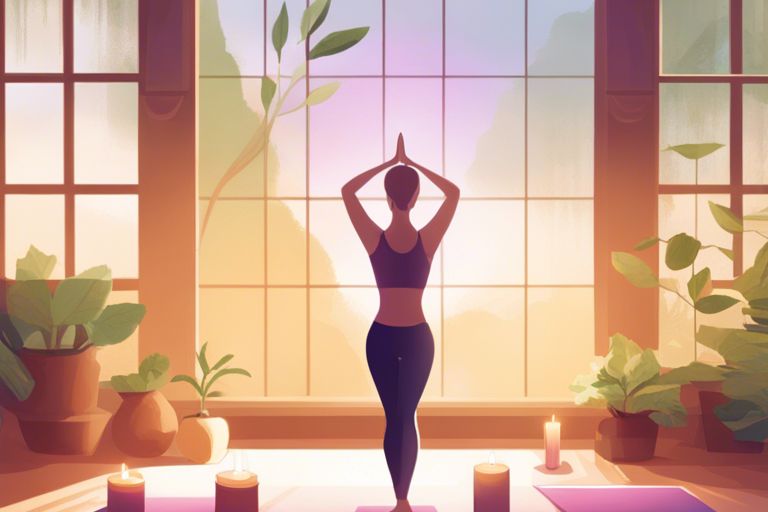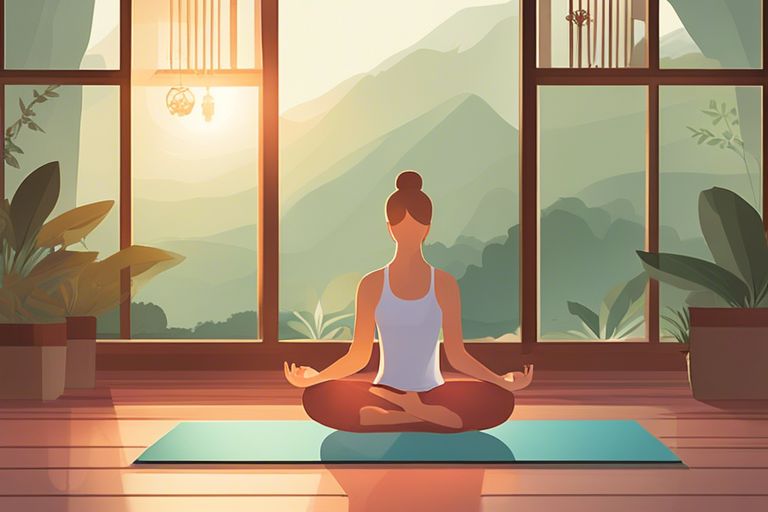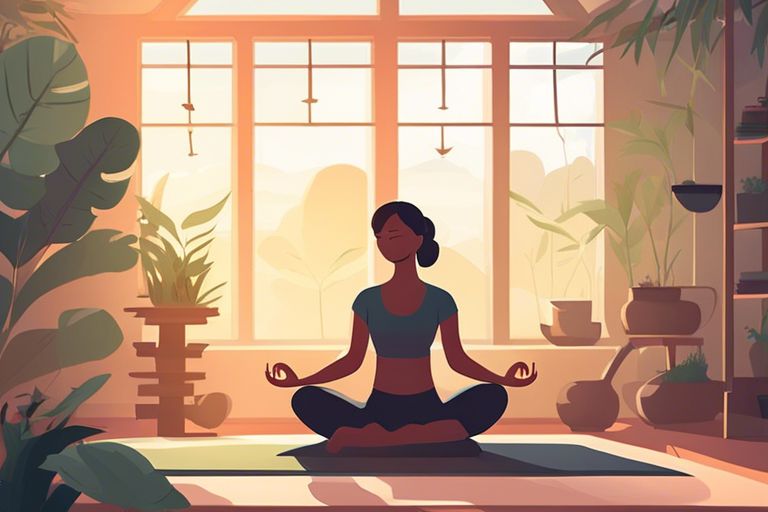Many people find starting a yoga routine intimidating, but with this step-by-step guide, you can ease into a yoga workout plan without feeling overwhelmed. In this beginner-friendly program, you will learn the basics of yoga poses, breathing techniques, and mindfulness practices to help you build strength, flexibility, and inner peace at your own pace. By following these simple steps, you will be on your way to a healthier, balanced lifestyle in no time.

Key Takeaways:
- Start Slow: If you are new to yoga, it’s important to start slow and focus on mastering the basic poses before moving on to more advanced ones.
- Consistency is Key: Consistency in practicing yoga is crucial for growth and progress. Setting aside time each day or a few times per week to practice will help you improve flexibility and build strength.
- Listen to Your Body: Pay attention to how your body feels during each pose and practice. It’s important to listen to your body and not push yourself beyond your limits to prevent injury. Modify poses as needed to accommodate your body’s needs.
1. Start with simple poses like child’s pose and downward dog.
2. Focus on breathing deeply and relaxing the body.
3. Move into poses like warrior I and tree pose.
4. Gradually increase intensity with poses like plank and cobra.
5. Include stretches like seated forward fold and pigeon pose.
6. End with relaxation in corpse pose to cool down.

Understanding Yoga Types
Your journey into the world of yoga begins with understanding the different types of yoga practices available to you. Each yoga type has its unique focus and benefits, catering to different needs and preferences. Here is a breakdown of some popular yoga types you may encounter on your yoga journey:
| Hatha Yoga | Vinyasa Yoga |
| Ashtanga Yoga | Iyengar Yoga |
| Kundalini Yoga |
Hatha Yoga
Yoga beginners often start with Hatha yoga as it provides a foundation for other styles. It focuses on basic yoga poses and breathing techniques, making it a great starting point for those new to yoga. To deepen your yoga practice, you can follow a 30-Minute Yoga Sequence to Reset Your Day.
Vinyasa Yoga
To engage in a more dynamic form of yoga, Vinyasa yoga offers a flowing sequence of poses synchronized with your breath. It focuses on smooth transitions between poses, creating a continuous movement that can be both challenging and energizing. It helps build strength, flexibility, and mindfulness in your yoga practice.
Ashtanga Yoga
Clearly, Ashtanga yoga follows a specific sequence of poses that are progressively more challenging. This vigorous style of yoga aims to synchronize breath with movement to create an intense internal heat. Vinyasa transitions between poses help maintain the flow and focus of this practice.
Iyengar Yoga
An Iyengar yoga practice emphasizes alignment and precision in each pose. By using props like blocks and straps, practitioners can achieve proper alignment and engage in poses with greater awareness. This style helps improve posture, strength, and flexibility through detailed instruction and holding poses for longer durations.
Kundalini Yoga
While all yoga types focus on the physical body, Kundalini yoga places a strong emphasis on the spiritual and energetic aspects of the practice. The goal is to awaken the dormant energy located at the base of the spine through a combination of dynamic movements, breathing techniques, meditation, and chanting. Types of practices can vary widely and may include kriyas (specific sequences of movements), pranayama (breathwork), and meditation to help you tap into your inner power and consciousness.
Any questions?
Factors to Consider Before Starting a Yoga Workout Plan
For a successful start to your yoga workout plan, there are several factors to consider to ensure safety and effectiveness. Here are the key aspects to keep in mind:
Age and Health Status
There’s no age limit to start practicing yoga, but it’s imperative to consider your health status before venturing into a new workout routine. If you have any pre-existing medical conditions or injuries, it’s crucial to consult with your healthcare provider or a certified yoga instructor to determine if yoga is suitable for you. Your physical limitations should be taken into account to avoid any potential risks during your practice. This will ensure that you can tailor the exercises according to your needs and capabilities.
Fitness Level and Goals
For a successful yoga workout plan, it’s important to assess your fitness level and have clear goals in mind. Whether you are a beginner or have some experience with yoga, it’s important to choose a practice that challenges you but also feels achievable. Setting specific goals, such as increasing flexibility, building strength, or improving mindfulness, can help you stay motivated and track your progress. This will also help you choose the right style and intensity of yoga practice that align with your objectives.
Another factor to consider is your preferred style of yoga – whether it’s Hatha, Vinyasa, Restorative, or Hot yoga. Each style offers unique benefits and challenges, so selecting one that resonates with you will enhance your overall experience and growth in the practice.
Available Time and Space
Plan your yoga workout routine according to your available time and space constraints. Determine how many days a week and for how long you can dedicate to your practice. It’s important to create a consistent schedule that fits into your daily routine. Additionally, make sure you have a quiet and clutter-free space where you can comfortably practice without distractions.
Workout at a time when you are most energized and focused, whether it’s early in the morning to start your day on a positive note or in the evening to wind down and relax. Consistency is key to progress in yoga, so finding a time that works best for you will help you stay committed to your practice.
Budget and Equipment Needs
Some Yoga classes and equipment can be pricey, so it’s important to consider your budget before starting a yoga workout plan. Research affordable options such as online classes, community centers, or free resources to fit your financial constraints. You can also invest in imperative equipment like a yoga mat, blocks, and straps, but make sure to prioritize based on your practice needs and budget.
Equipment can enhance your practice by improving alignment and support in poses, ultimately reducing the risk of injuries. However, remember that you can always start with the basics and gradually add more props as you progress in your practice.
Tips for a Successful Yoga Workout Plan
Not sure where to start with your yoga workout plan? Here are some tips to help you make the most out of your practice:
- Create a schedule and stick to it consistently
- Warm up and cool down properly
- Listen to your body and avoid injury
- Find a yoga style that suits you
Perceiving these tips can help you achieve a successful and fulfilling yoga workout routine.
Creating a Schedule and Sticking to It
There’s no need to overwhelm yourself by trying to practice yoga every day for hours. You can start with just a few days a week for shorter sessions and gradually build up from there, depending on your schedule and commitments.
Warming Up and Cooling Down Properly
One of the most important aspects of a successful yoga practice is warming up and cooling down properly. Take at least 5-10 minutes at the beginning of your practice to gently stretch and prepare your body for the more intense poses. Cooling down at the end of your session with some relaxing stretches can help prevent injury and stiffness.
Listening to Your Body and Avoiding Injury
There’s a difference between pushing yourself to improve and pushing yourself to the point of injury. Your body will tell you what it needs if you pay attention. If a pose is causing pain or discomfort, back off and modify as needed. It’s important to respect your body’s limits to avoid injury and ensure a safe practice.
Finding a Yoga Style That Suits You
Warming up properly before your practice can help prevent injuries and improve the effectiveness of your yoga routine. Different yoga styles offer unique benefits, so finding one that resonates with you can make your practice more enjoyable and fulfilling. Whether you prefer a slow and gentle practice like Hatha yoga or a more dynamic and challenging vinyasa flow, there’s a style out there that will suit your preferences and fitness goals.

Step-by-Step Yoga Workout Plan for Beginners
Once again, yoga is a fantastic way to improve your flexibility, strength, and overall well-being. To get started on your yoga journey, here is a step-by-step workout plan for beginners that will help you gradually build your practice over eight weeks.
Week 1-2: Foundational Poses and Breathing Techniques
Poses
| 1. Mountain Pose | 2. Child’s Pose |
| 3. Downward Facing Dog | 4. Cobra Pose |
Breathing Techniques
| 1. Deep Belly Breathing | 2. Ujjayi Breath |
Clearly, during the first two weeks, you will focus on mastering foundational yoga poses and important breathing techniques to set a strong base for your practice.
Week 3-4: Building Strength and Flexibility
Poses
| 1. Warrior I | 2. Warrior II |
| 3. Triangle Pose | 4. Bridge Pose |
To advance in your practice, you will start incorporating poses that help build strength and flexibility in the third and fourth weeks. These poses will challenge you to push your limits while enhancing your overall fitness.
Breathing Techniques
| 1. Kapalabhati Breath | 2. Alternate Nostril Breathing |
Common Mistakes to Avoid in Yoga Practice
Overstretching and Ignoring Pain
Now, one common mistake beginners make in yoga practice is overstretching and ignoring pain. It’s vital to listen to your body and not push yourself beyond your limits. While yoga is about challenging yourself, pushing too hard can lead to injury and setbacks in your practice. Recall, yoga is a journey, and progress takes time.
Poor Alignment and Form
Poor alignment and form are common mistakes that can impact the effectiveness of your yoga practice. When your alignment is off, you may not be getting the full benefits of the pose, and you could be putting strain on the wrong muscles. It’s important to focus on proper alignment and form in each pose to prevent injuries and ensure that you are engaging the right muscles.
Another aspect of poor alignment is the risk of imbalance in the body. When one side is stronger or more flexible than the other, it can lead to compensations and potential injuries. Paying attention to alignment and form can help you create balance and symmetry in your practice.
Holding Breath and Ignoring Breathing Techniques
Overstretching Mistakes in yoga can also include holding your breath and ignoring proper breathing techniques. Your breath is an vital component of yoga practice as it helps you connect with your body and stay present in the moment. Holding your breath can create tension in the body and make it harder to move smoothly between poses. Remember to focus on your breath and use it to guide you through each movement.
Comparing Yourself to Others
If you find yourself comparing your yoga practice to others, it can take away from your own experience and progress. Everyone’s body is unique, and what works for one person may not work for another. Instead of focusing on what others are doing, pay attention to your own journey and celebrate your small victories along the way.
| Negative Effects | Positives |
| Increases self-doubt | Allows you to focus on your own progress |
| Creates unnecessary competition | Promotes a sense of self-acceptance |
Comparing yourself to others can lead to feelings of inadequacy or frustration. Remember that yoga is a personal practice, and everyone’s journey looks different. Embrace where you are in your practice and stay focused on your own growth.
Pros and Cons of Different Yoga Styles
After exploring various yoga styles, it is important to understand the pros and cons of each to find the best fit for your needs. Below, you will find a breakdown of the advantages and disadvantages of popular yoga styles in tables for easy comparison.
Hatha Yoga: Pros and Cons
Pros:
| Pros | Cons |
| Great for beginners | Less intense workout |
| Focuses on basic poses and breathing techniques | May not offer a vigorous workout for advanced practitioners |
Cons:
Vinyasa Yoga: Pros and Cons
Pros:
| Pros | Cons |
| Provides a more dynamic and challenging practice | Fast-paced flow might be overwhelming for beginners |
| Improves flexibility and strength | Less focus on alignment compared to Hatha yoga |
Different
Vinyasa Yoga is known for its fluid sequencing of postures coordinated with breath, creating a continuous flow. It is a popular style for those looking for a more dynamic and challenging practice.
Ashtanga Yoga: Pros and Cons
Pros:
| Pros | Cons |
| Structured sequence allows for progression | High intensity may not be suitable for everyone |
| Builds stamina and endurance | Risk of overuse injuries if not practiced mindfully |
Pros
Ashtanga Yoga is a physically demanding practice that follows a specific sequence of postures. This style is excellent for building strength, stamina, and focus.
Iyengar Yoga: Pros and Cons
Pros:
| Pros | Cons |
| Emphasizes proper alignment and precision | Less dynamic movement compared to Vinyasa |
| Uses props for support and to deepen poses | Poses may be held for a longer duration |
Some
Iyengar Yoga is a style that focuses on alignment and precision in each posture. With the use of props, this practice helps you achieve a deeper understanding of the poses and their benefits.
Kundalini Yoga: Pros and Cons
Pros:
| Pros | Cons |
| Works on the mind, body, and spirit connection | Some kriyas (sequences) can be intense and challenging |
| Focuses on breathwork and meditation | Emotional release may occur during practice |
Assuming
This style of yoga aims to activate the energy at the base of the spine and draw it upward through the chakras. Kundalini Yoga combines dynamic movements, breathing techniques, meditation, and the chanting of mantras.
This is an overview of the pros and cons of different yoga styles to help you choose the right one for your practice. Keep in mind that each style offers unique benefits, so feel free to explore and find what resonates with you best.
Final Words
As a reminder, starting a beginner’s yoga workout plan can be a great way to improve your flexibility, strength, and overall well-being. By following this step-by-step guide, you have all the tools you need to begin your yoga journey.
Remember to focus on your breath, listen to your body, and progress at your own pace. With consistency and dedication, you will begin to see improvements in both your physical and mental health. Embrace the journey and enjoy the many benefits that yoga has to offer. Namaste!
Q: Is yoga suitable for beginners?
A: Yes, yoga is suitable for beginners. There are plenty of yoga poses and sequences designed specifically for those who are new to the practice. With proper guidance and instruction, beginners can gradually build strength, flexibility, and mindfulness through yoga.
Q: How often should beginners practice yoga?
A: For beginners, it is recommended to start with 2-3 yoga sessions per week. This allows time for the body to adapt to the new movements and for beginners to gradually build strength and flexibility. As one becomes more comfortable with the practice, they can gradually increase the frequency of their yoga sessions.
Q: What are some beginner-friendly yoga poses to include in a workout plan?
A: Some beginner-friendly yoga poses to include in a workout plan are:
- Mountain Pose (Tadasana)
- Child’s Pose (Balasana)
- Warrior I (Virabhadrasana I)
- Downward Facing Dog (Adho Mukha Svanasana)
- Cobra Pose (Bhujangasana)
- Corpse Pose (Savasana)
These poses help improve strength, flexibility, and relaxation for beginners starting their yoga journey.











